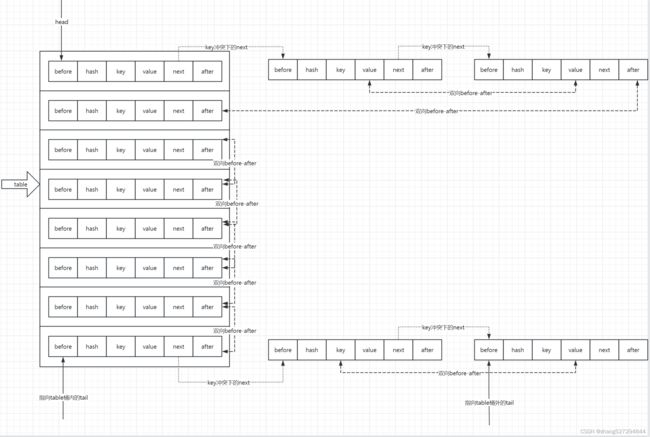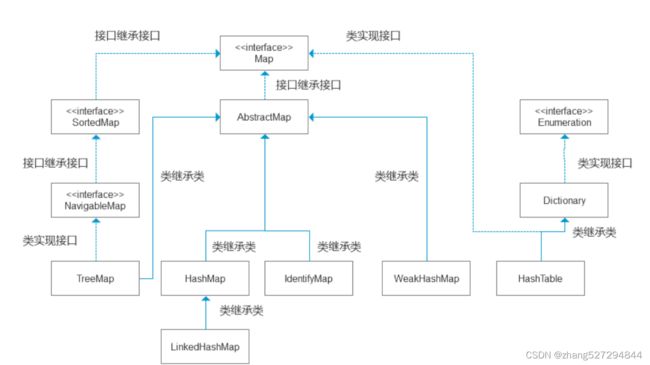LinkedHashMap源码分析
类结构图
从类图结构可以看出,LinkedHashMap继承自HashMap,里面很多实现都是HashMap的,这篇文章主要写出LinkedHashMap自实现的那部分
Entry
LinkedHashMap的每个元素项都是一个Entry类对象,该类继承自HashMap.Node类
static class Entry<K,V> extends HashMap.Node<K,V> {
Entry<K,V> before, after; //增加了前后引用指向,实现双向链表
Entry(int hash, K key, V value, Node<K,V> next) {
super(hash, key, value, next);
}
}
数据结构图
最终LinkedHashMap的存储结构,包含有数组、单链表(维持HashMap中的key冲突情况)、双链表(LinkedHashMap的主结构)、红黑树(维持HashMap中的key冲突情况),具体如下图:

上图中的tail在实际中可能出现在两种位置,第1种位置是指向table桶内的值,并且该entry没有hash冲突;第2种是在有hash冲突下的指向,两者只会存在其中一种
put
LinkedHashMap的put实现完全继承HashMap的逻辑,作为子类,在newNode和afterNodeInsertion两个方法上做了重写,所以我们重点关注这2个方法
final V putVal(int hash, K key, V value, boolean onlyIfAbsent,
boolean evict) {
Node<K,V>[] tab; Node<K,V> p; int n, i;
if ((tab = table) == null || (n = tab.length) == 0)
n = (tab = resize()).length;
if ((p = tab[i = (n - 1) & hash]) == null)
tab[i] = newNode(hash, key, value, null); //LinkedHashMap对newNode方法重写了
else {
Node<K,V> e; K k;
if (p.hash == hash &&
((k = p.key) == key || (key != null && key.equals(k))))
e = p;
else if (p instanceof TreeNode)
e = ((TreeNode<K,V>)p).putTreeVal(this, tab, hash, key, value);
else {
for (int binCount = 0; ; ++binCount) {
if ((e = p.next) == null) {
p.next = newNode(hash, key, value, null);
if (binCount >= TREEIFY_THRESHOLD - 1) // -1 for 1st
treeifyBin(tab, hash);
break;
}
if (e.hash == hash &&
((k = e.key) == key || (key != null && key.equals(k))))
break;
p = e;
}
}
if (e != null) { // existing mapping for key
V oldValue = e.value;
if (!onlyIfAbsent || oldValue == null)
e.value = value;
afterNodeAccess(e);
return oldValue;
}
}
++modCount;
if (++size > threshold)
resize();
afterNodeInsertion(evict); //LinkedHashMap实现了afterNodeInsertion
return null;
}
创建LinkedHashMap的节点
Node<K,V> newNode(int hash, K key, V value, Node<K,V> e) {
//创建节点
LinkedHashMap.Entry<K,V> p =
new LinkedHashMap.Entry<K,V>(hash, key, value, e);
linkNodeLast(p);
return p;
}
private void linkNodeLast(LinkedHashMap.Entry<K,V> p) {
//保留最后一个节点信息
LinkedHashMap.Entry<K,V> last = tail;
tail = p; //将当前节点置为尾节点
if (last == null)
head = p; //原尾节点为空,就是链表为空,当前节点就是头节点head了
else { //原链表不为空,设置当前节点的before节点为原尾节点tail,原尾节点的after为当前节点p,实现双向入链
p.before = last;
last.after = p;
}
}
节点插入后的操作afterNodeInsertion钩子方法
void afterNodeInsertion(boolean evict) { // possibly remove eldest
LinkedHashMap.Entry<K,V> first;
//由于removeEldestEntry方法固定返回false,所以这个if永远进不去
if (evict && (first = head) != null && removeEldestEntry(first)) {
//其时这个方法内部,意思就是尾部插入一个新node,然后移除一个老的头部的node,这点有没有感觉像是LRU算法实现的逻辑
K key = first.key;
removeNode(hash(key), key, null, false, true);
}
}
protected boolean removeEldestEntry(Map.Entry<K,V> eldest) {
return false;
}
get
public V get(Object key) {
Node<K,V> e;
if ((e = getNode(hash(key), key)) == null)
return null;
if (accessOrder) // accessOrder默认是false,可以在构造方法中设置为true
afterNodeAccess(e); //把节点移到最后,其实还是LRU算法实现的逻辑,把最新访问的放到链表尾部
return e.value;
}
void afterNodeAccess(Node<K,V> e) { // 把节点移动最后
LinkedHashMap.Entry<K,V> last;
if (accessOrder && (last = tail) != e) {
/*
当前节点p,p的前置节点b,p的后继节点a,关系如下:
b<->p<->a
*/
LinkedHashMap.Entry<K,V> p =
(LinkedHashMap.Entry<K,V>)e, b = p.before, a = p.after;
//当前节点要被扔到最后,所以after为null
p.after = null;
//b为null,表示当前p就是head节点,直接到a置为head就行
if (b == null)
head = a;
else
b.after = a; //p不是head,那么b的after就要变成a了
if (a != null)
a.before = b; //a的before也要改成b了
else
last = b; // a也是null,那最后一个节点就b自己了
if (last == null) //到这证明,从头到尾只有p一个节点,那只能自己变成head
head = p;
else {
p.before = last; //把p丢到尾部
last.after = p;
}
tail = p;
++modCount; //修改次数加1
}
}
